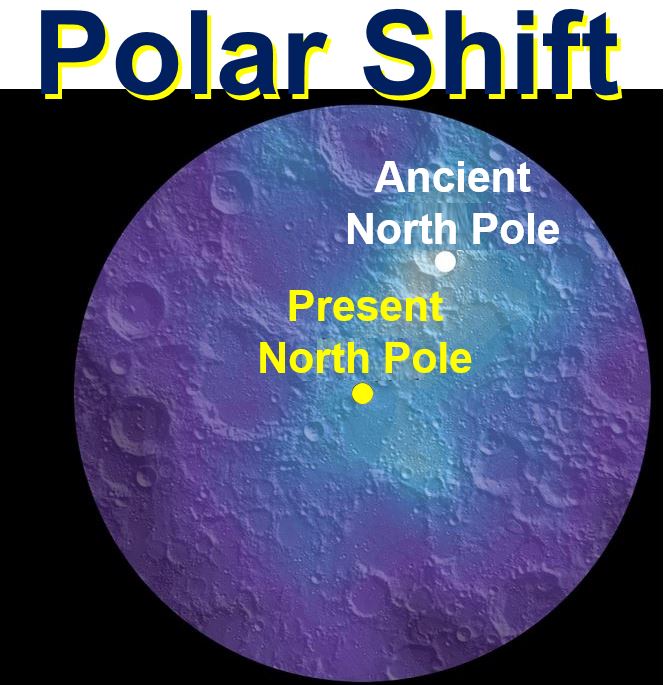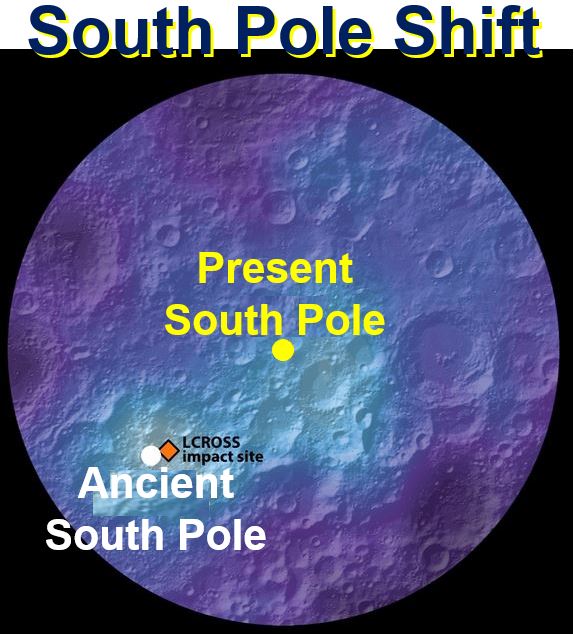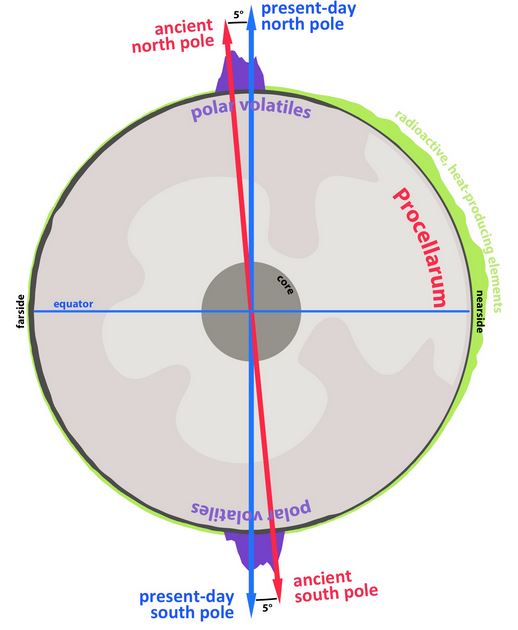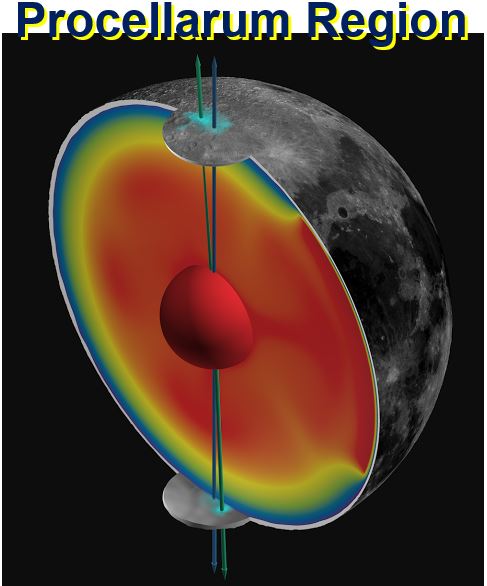The spin axis of the Moon shifted about 5 degrees approximately 3 billion years ago, say researchers after completing a NASA-funded study. They came to this conclusion after analyzing the distribution of ancient lunar ice at the two poles – evidence of delivery of water to the early Solar System.
It is very likely, the scientists explained in the prestigious journal Nature (citation below), that three billion years ago, the ‘man in the moon’ looked a bit different.
 This polar hydrogen map of the Moon’s northern hemisphere identifies the location of its ancient and present day north pole. Lighter areas show higher concentrations of hydrogen and the darker areas show lower concentrations. In the image below, you can see how the South Pole shifted. (Image: nasa.gov. Credits: James Keane & Richard Miller)
This polar hydrogen map of the Moon’s northern hemisphere identifies the location of its ancient and present day north pole. Lighter areas show higher concentrations of hydrogen and the darker areas show lower concentrations. In the image below, you can see how the South Pole shifted. (Image: nasa.gov. Credits: James Keane & Richard Miller)
Man in the Moon changed
Lead author Matthew Siegler, who works at the Planetary Science Institute in Tucson, Arizona, said:
“The same face of the moon has not always pointed towards Earth. As the axis moved, so did the face of the ‘man in the moon.’ He sort of turned his nose up at the Earth.”
Water ice can exist in areas of permanent shadow on our Moon. If Moon ice is exposed to direct sunlight, it evaporates and disappears into space.
In this study, the researchers show evidence that a shift of the Moon’s spin axis billions of years ago enabled sunlight to get into areas that had been shadowed and probably contained ice.
 The Moon’s South Pole shifted just like in the first image, but in the opposite direction. (Image: nasa.gov. Credits: James Keane & Richard Miller)
The Moon’s South Pole shifted just like in the first image, but in the opposite direction. (Image: nasa.gov. Credits: James Keane & Richard Miller)
Surviving ice paints a path
The scientists found that the surviving ice effectively ‘paints’ a path along which the axis shifted.
They compared the observed path with models that predicted where the ice could remain stable, and inferred that the Moon’s axis had shifted by about 5 degrees.
This is the first compelling physical evidence that the Moon underwent such a dramatic orientation change. It also suggests that most of the Moon’s polar ice is billions of years old.
Co-author, Dr. Yvonne Pendleton, director or SSERVI (NASA’s Solar System Exploration Research Virtual Institute), said:
“The new findings are a compelling view of the moon’s dynamic past. It is wonderful to see the results of several missions pointing to these insights.”
The authors analyzed data from a number of NASA missions, including the Gravity Recovery and Interior Laboratory (GRAIL), Lunar Crater and Observation Sensing Satellite (LCROSS), Lunar Prospector, and Lunar Reconnaissance Orbiter (LRO), to build a case for a shift in the Moon’s orientation.
 A cross-section through the Moon, highlighting the antipodal nature of lunar polar volatiles (purple), and how they trace an ancient spin pole. The reorientation from that ancient spin pole (red arrow) to the pcurrent spin pole (blue arrow) was driven by the formation and evolution of the Procellarum – a region on the nearside of the Moon associated with a high concentrations of radiogenic heat producing elements (green), high heat flow, and ancient volcanic activity. (Image: nasa.gov. Credit: James Tuttle Keane)
A cross-section through the Moon, highlighting the antipodal nature of lunar polar volatiles (purple), and how they trace an ancient spin pole. The reorientation from that ancient spin pole (red arrow) to the pcurrent spin pole (blue arrow) was driven by the formation and evolution of the Procellarum – a region on the nearside of the Moon associated with a high concentrations of radiogenic heat producing elements (green), high heat flow, and ancient volcanic activity. (Image: nasa.gov. Credit: James Tuttle Keane)
Topography from LOLA (Lunar Orbiter Laser Altimeter) and the Diviner Lunar Radiometer’s thermal measurements were used to help in the interpretation of Lunar Prospector neutron data that support the polar wander hypothesis.
Polar ice had precisely opposite movements
Dr. Siegler noticed that the distribution of ice they observed at each of the Moon’s poles appeared to be more related to each other than previously thought.
Dr. Siegler and co-author Richard Miller, from the University of Alabama at Huntsville, discovered that ice concentrations were displaced from each pole at identical distances, however, in precisely opposite directions. This suggests that the spin axis had been tilted from what we see today.
A shift in the Moon’s tilt means that some of the ancient ice has since evaporated because it was exposed to sunlight. However, those areas that remain in permanent shadow between the old and new orientations retain their ice, and thus indicate what occurred.
 A 3D cross section of the moon, showing the Procellarum region of the crust, that was likely responsible for the change in mass that caused the moon’s axis to tilt. (Image: nasa.gov. Credit: James Keane)
A 3D cross section of the moon, showing the Procellarum region of the crust, that was likely responsible for the change in mass that caused the moon’s axis to tilt. (Image: nasa.gov. Credit: James Keane)
A planet or moon can shift on its axis when there is a significant change in mass distribution. Co-author James Keane, of the University of Arizona in Tucson, modeled how changes in the Moon’s interior would have influenced its spin and tilt.
Procellarum region triggered the axis shift
He found that the Procellarum region on the Moon’s near side was the only feature that could match the direction and amount of axis shift indicated by the ice distributions near the poles.
Concentrations of radioactive material in the Procellarum region are enough to have heated part of the lunar mantle, causing a density change significant enough to reorient the Moon.
Some of the heated mantle material melted and came up to the surface to form the dark patches we can see today that fill large lunar basins we call mare. It is these mare patches that give the so-called Man on the Moon his ‘face’.
Dr. Siegler said:
“These findings may open the door to further discoveries on the interior evolution of the moon, as well as the origin of water on the moon and early Earth.”
In an Abstract in the journal, the authors wrote:
“The Procellarum region was most geologically active early in lunar history7, 8, 9, which implies that polar wander initiated billions of years ago and that a large portion of the measured polar hydrogen is ancient, recording early delivery of water to the inner Solar System.”
“Our hypothesis provides an explanation for the antipodal distribution of lunar polar hydrogen, and connects polar volatiles to the geologic and geophysical evolution of the Moon and the bombardment history of the early Solar System.”
Citation: “Lunar true polar wander inferred from polar hydrogen,” M. A. Siegler, I. Matsuyama, D. J. Lawrence, R. S. Miller, J. T. Keane, M. Laneuville, D. A. Paige, A. Crotts & M. J. Poston. Nature. 23 March 2016. DOI: 10.1038/nature17166.
Video – Moon Lunar Polar Wander
This video, produced by James Keane, shows how the Moon wandered off its original axis about 3 billion years ago.
